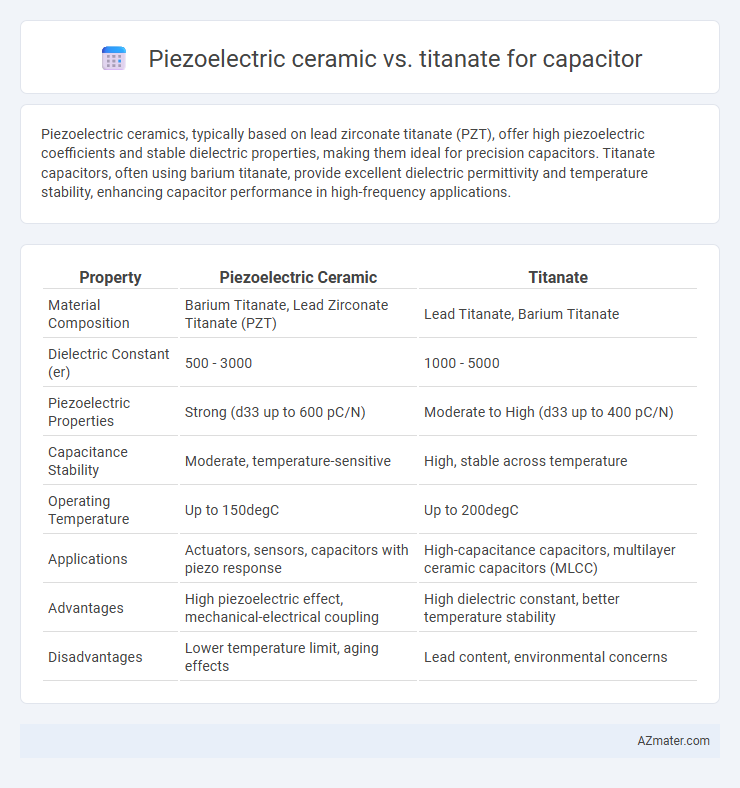Piezoelectric ceramics, typically based on lead zirconate titanate (PZT), offer high piezoelectric coefficients and stable dielectric properties, making them ideal for precision capacitors. Titanate capacitors, often using barium titanate, provide excellent dielectric permittivity and temperature stability, enhancing capacitor performance in high-frequency applications.
Table of Comparison
| Property | Piezoelectric Ceramic | Titanate |
|---|---|---|
| Material Composition | Barium Titanate, Lead Zirconate Titanate (PZT) | Lead Titanate, Barium Titanate |
| Dielectric Constant (er) | 500 - 3000 | 1000 - 5000 |
| Piezoelectric Properties | Strong (d33 up to 600 pC/N) | Moderate to High (d33 up to 400 pC/N) |
| Capacitance Stability | Moderate, temperature-sensitive | High, stable across temperature |
| Operating Temperature | Up to 150degC | Up to 200degC |
| Applications | Actuators, sensors, capacitors with piezo response | High-capacitance capacitors, multilayer ceramic capacitors (MLCC) |
| Advantages | High piezoelectric effect, mechanical-electrical coupling | High dielectric constant, better temperature stability |
| Disadvantages | Lower temperature limit, aging effects | Lead content, environmental concerns |
Overview of Piezoelectric Ceramics and Titanates
Piezoelectric ceramics, such as lead zirconate titanate (PZT), exhibit strong electromechanical coupling, making them ideal for sensors and actuators due to their ability to convert mechanical stress into electrical charge. Titanates, primarily barium titanate (BaTiO3), are widely used in capacitor applications due to their high dielectric constant and excellent temperature stability, enhancing energy storage capacity and reliability. The key difference lies in PZT's superior piezoelectric properties versus BaTiO3's dominant role in dielectric applications for capacitors.
Structural Differences Between Piezoelectric Ceramics and Titanates
Piezoelectric ceramics and titanates primarily differ in their crystal lattice structures, where piezoelectric ceramics often exhibit perovskite or tetragonal symmetry that facilitates electric charge generation under mechanical stress. Titanates, such as barium titanate (BaTiO3), possess a perovskite structure with a distinctive ferroelectric phase allowing for spontaneous polarization and high dielectric constants. These structural variations significantly influence their dielectric properties and piezoelectric coefficients, determining their suitability in capacitor applications.
Dielectric Properties Comparison
Piezoelectric ceramic capacitors exhibit higher dielectric constants and superior temperature stability compared to titanate-based capacitors, making them ideal for precision applications. Titanate capacitors typically offer moderate dielectric permittivity but excel in low dielectric loss and high insulation resistance. The choice between piezoelectric ceramic and titanate largely depends on requirements for dielectric constant, loss tangent, and thermal coefficient in capacitor design.
Capacitance Performance Analysis
Piezoelectric ceramics, primarily lead zirconate titanate (PZT), exhibit higher dielectric constants and greater electromechanical coupling compared to pure titanate ceramics, enhancing capacitance performance in capacitors under varying mechanical stresses. The enhanced permittivity of PZT materials results in superior energy storage capabilities and improved capacitance stability over temperature fluctuations, making them ideal for precision applications. In contrast, pure titanate ceramics typically offer lower dielectric constants and reduced electromechanical sensitivity, limiting their capacitive efficiency in high-performance or dynamic environments.
Temperature Stability and Reliability
Piezoelectric ceramics, such as lead zirconate titanate (PZT), exhibit superior temperature stability with consistent dielectric properties up to around 200degC, making them ideal for high-reliability capacitor applications under varying thermal conditions. Titanate-based capacitors, while effective at room temperature, often experience significant changes in capacitance and increased dielectric losses above 125degC, limiting their performance in demanding thermal environments. The overall reliability of piezoelectric ceramics is enhanced by their lower aging rates and resistance to thermal degradation compared to titanate capacitors, ensuring longer operational lifespans in temperature-sensitive applications.
Frequency Response Characteristics
Piezoelectric ceramics, such as lead zirconate titanate (PZT), exhibit a high-frequency response with superior electromechanical coupling coefficients, making them ideal for applications requiring precise and rapid signal conversion. Titanate-based capacitors demonstrate a relatively stable frequency response with lower dielectric losses, but their response is generally limited at higher frequencies compared to specialized piezoelectric ceramics. The frequency-dependent impedance of piezoelectric ceramics enables enhanced sensitivity and bandwidth in resonant devices, while titanate capacitors prioritize low dielectric constant stability across a moderate frequency range.
Manufacturing Processes and Cost Factors
Piezoelectric ceramics typically involve complex sintering and poling processes that require precise temperature control and high-purity raw materials, increasing manufacturing complexity and costs. Titanate capacitors, especially those using barium titanate, benefit from more established and scalable production methods with lower material and processing expenses, making them cost-effective for large-scale applications. The choice between these materials balances the higher performance and sensitivity of piezoelectric ceramics against the economic efficiency and mass production advantages of titanate capacitors.
Applications in Modern Capacitors
Piezoelectric ceramics, primarily lead zirconate titanate (PZT), offer high dielectric constants and strong electromechanical coupling, making them ideal for sensors, actuators, and energy harvesting capacitors in advanced electronics. Titanate-based capacitors, such as barium titanate capacitors, provide excellent dielectric stability and high capacitance density, which are essential in multilayer ceramic capacitors (MLCCs) used in consumer electronics and automotive applications. Modern capacitors leverage PZT for precision piezoelectric applications, while titanate ceramics dominate in high-volume, cost-effective MLCC production due to their reliable dielectric properties and scalability.
Environmental and Safety Considerations
Piezoelectric ceramics, such as lead zirconate titanate (PZT), contain lead, raising environmental concerns due to lead toxicity and strict regulations like RoHS limiting their usage. Titanate-based capacitors, often lead-free alternatives like barium titanate, offer safer environmental profiles with reduced hazardous material content and improved recyclability. Choosing titanate capacitors enhances compliance with environmental safety standards while minimizing ecological impact and health risks associated with lead-based piezoelectric ceramics.
Choosing Between Piezoelectric Ceramic and Titanate for Capacitors
Piezoelectric ceramics offer high dielectric constants and excellent electromechanical coupling, making them ideal for capacitors requiring precise tuning and energy conversion. Titanate materials, such as barium titanate, provide superior temperature stability and higher dielectric strength, enhancing capacitor performance under varying environmental conditions. Selecting between piezoelectric ceramic and titanate depends on specific capacitor requirements like frequency response, thermal stability, and dielectric permittivity.

Infographic: Piezoelectric ceramic vs Titanate for Capacitor
 azmater.com
azmater.com